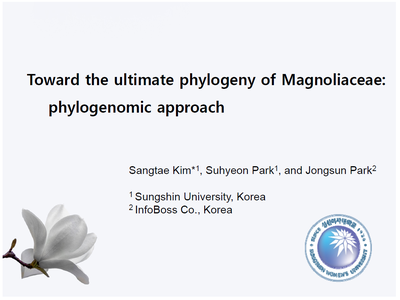Toward the ultimate phylogeny of Magnoliaceae: phylogenomic approach
SANGTAE KIM, Keynote Speaker
Dept. of Biotechnology, Sungshin University, Seoul, 01133, Rep. of Korea
In the recent studies of molecular phylogeny of angiosperms, Magnoliaceae is included in the magnoliids clade which is placed at the base of angiosperm phylogenetic tree after Amborellales, Nymphaeales, and Austrobaileyales. Although Magnoliaceae is not a most-basal angiosperm in the updated angiosperm phylogenetic tree, it is still a member of early diverging angiosperms. Therefore, the understanding of the phylogeny of Magnoliaceae plays a key role in explaining the diversification and evolution of angiosperms. In the early studies of molecular phylogeny, various approaches have been conducted on Magnoliaceae such as studies based on chloroplast RFLP, and sequencing of a single gene or a few multiple genes. Although these studies showed major lineages in the Magnoliaceae, the evolution of Magnoliaceae remained unclear in many parts, especially the relationships among major lineages in the family. Since the overall base substitution rate in Magnoliaceae is very low compared with other angiosperm groups, adding the more DNA regions to the analyses is needed for getting a better phylogenetic tree. In this study, we used a genome-wide approach on nuclear genome with high throughput target-enrichment NGS sequencing. We identified 504 putative single/low copy gene regions (443 kbp) as targets for captured NGS sequencing. These regions are 1) expressed single-copy genes extracted from a preliminary genome assembly of Magnolia kobus (ver. 0.4; see talk 1401) using gene clustering (Tribe-Mcl) with its transcriptomes and 2) shared single/low copy genes among Arabidopsis, Populus, Oryza, Vitis, and M. kobus. Probes of these regions were designed and hybridized with 130 taxa representing all previously reported sublineages (sections and tribes) of Magnoliaceae. Index sequences were added in the captured fragments and sequenced altogether using the Illumina HiSeq platform. Phylogenetic trees based on exons of targeted nuclear genes as well as adjacent intergenic sequences (including introns) were compared with those based on chloroplast genome data. The results will provide a basis for the evolutionary diversification in the family as well as a new classification system of Magnoliaceae.

